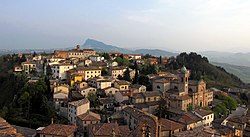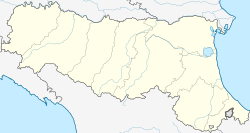Verucchio
You can help expand this article with text translated from the corresponding article in Italian. (January 2022) Click [show] for important translation instructions.
|
Verucchio | |
|---|---|
| Comune di Verucchio | |
 Verucchio | |
| Coordinates: 43°59′N 12°26′E / 43.983°N 12.433°E | |
| Country | Italy |
| Region | Emilia-Romagna |
| Province | Rimini (RN) |
| Frazioni | Villa Verucchio, Ponte Verucchio, Pieve Corena |
| Area | |
| • Total | 27 km2 (10 sq mi) |
| Elevation | 330 m (1,080 ft) |
| Population (31 December 2004)[2] | |
| • Total | 9,365 |
| • Density | 350/km2 (900/sq mi) |
| Demonym | Verucchiesi |
| Time zone | UTC+1 (CET) |
| • Summer (DST) | UTC+2 (CEST) |
| Postal code | 47826 |
| Dialing code | 0541 |
| Patron saint | Saint Martin |
| Saint day | November 11 |
| Website | Official website |
Verucchio (Romagnol: Vròcc) is a comune in the province of Rimini, region of Emilia-Romagna, Italy. It has a population of about 9,300 and is 18 kilometres (11 mi) from Rimini, on a spur overlooking the valley of the Marecchia river. It is one of I Borghi più belli d'Italia ("The most beautiful villages of Italy").[3]
History
[edit]Traces of a 12th-9th century BC settlement, supposed of Villanovan origin, have been found overlooking the Adriatic plain. Later it was an Etruscan possession. The current town derives its name from Vero Occhio ("True Eye"), referring to its privileged position offering a wide panorama of the surrounding countryside and the Romagna coast.
Malatesta da Verucchio, founder of the Malatesta lordship of Romagna, was born here. His successors fortified it as a powerful bastion against the Montefeltro of Urbino. After the expulsion of the Malatesta (15th century), it was a fief of the Medici in the Papal States; it remained part of the latter, with a short stint under the Republic of Venice, until 1620.
Between 1916 and 1960, Verucchio was served by the Rimini–Novafeltria railway, with stops at Villa Verucchio and Ponte Verucchio;[4][5] the latter stop, named simply Verucchio, was opened with the railway's extension to San Marino-Torello in 1921.[4][5] The railway's most-used section was between Rimini and Villa Verucchio.[6] Following its closure, much of the railway was incorporated into the SP258 provincial road.[7][8] To allow the road's widening,[9][10] the tracks in the province of Forlì were removed in 1964, costing 17.5 million lire.[10] Both station buildings in Verucchio are extant: Villa Verucchio's is used by buses, while Verucchio's houses a United Nations research centre.[4]
Verucchio was also supposed to be served by the Santarcangelo–Urbino railway, also known as the subappenine railway, which would have connected Santarcangelo di Romagna with Urbino. The project was intended to provide an inland alternative to the Bologna–Ancona railway, whose coastal position made it vulnerable to bombardment. It was abandoned in 1933, but some tracks had already been laid in the section from Santarcangelo to San Leo. Some of these tracks were reused by the Rimini–Novafeltria railway along a new post-war alignment.[11]
On 16 April 1992, the municipality transferred from the province of Forlì to the newly created province of Rimini.[12]
Demographic evolution
[edit]
Main sights
[edit]
- Rocca Malatestiana (Malatesta Castle, 12th-16th century; also known as Castel del Sasso, or "Castle of the Rock"). It is one of largest and better conserved Malatestian fortifications, and was the birthplace of Malatesta da Verucchio. In 1449 Sigismondo Pandolfo Malatesta enlarged it.
- Archaeological Museum
- Rocca del Passerello with the annexed gate.
- Romanesque-Gothic Pieve, dating around 990.
- Franciscan Convent (c. 1215), the most ancient in Romagna. Inside the church is a masterpiece of the 13th century Riminese painting school representing the crucifixion. Outside is a 700-year-old cypress that, according to the legend, was planted by St. Francis himself.

References
[edit]- ^ "Superficie di Comuni Province e Regioni italiane al 9 ottobre 2011". Italian National Institute of Statistics. Retrieved 16 March 2019.
- ^ "Popolazione Residente al 1° Gennaio 2018". Italian National Institute of Statistics. Retrieved 16 March 2019.
- ^ "Emilia Romagna" (in Italian). Retrieved 31 July 2023.
- ^ a b c "Ferrovia Rimini Centrale-Novafeltria" [Rimini Centrale-Novafeltria railway]. www.ferrovieabbandonate.it. Retrieved 10 December 2023.
- ^ a b "18 giugno 1922 - Completata la ferrovia Rimini - Novafeltria" [18 June 1922: The Rimini-Novafeltria railway is completed]. Chiamami Città (in Italian). 17 June 2023. Retrieved 23 November 2023.
- ^ "Risposte scritte ad interrogazioni" [Written responses to questions] (PDF). Atti Parlamentari. Seduta del 13 ottobre 1958. Chamber of Deputies: 330–331. 13 October 1958. Retrieved 1 February 2024.
- ^ Zaghini, Paolo (11 September 2022). "Se in Valmarecchia ci fosse ancora il trenino dello zolfo" [If only the sulphur train still existed in Valmarecchia]. Chiamami Città (in Italian). Retrieved 1 February 2024.
- ^ "Ferrovia Rimini Centrale-Novafeltria" [Rimini Centrale-Novafeltria railway]. www.ferrovieabbandonate.it. Retrieved 10 December 2023.
- ^ Preti, Luigi (30 January 1960). "N. 1986 Trasferimento nei ruoli del personale delle ferrovie dello Stato del personale in servizio nella ferrovia Rimini–Novafeltria" [N. 1986 Transfer of personnel serving on the Rimini–Novafeltria railway to the roles of state railway personnel] (PDF). Atti Parlamentari. III Legislatura Disegni di Legge e Relazioni. Chamber of Deputies: 330–331. Retrieved 1 February 2024.
- ^ a b Pagliarani, Nicola (31 August 1964). "Risposte scritte ad interrogazioni" [Written responses to questions] (PDF). Atti Parlamentari. Seduta del 31 agosto 1964. Chamber of Deputies: 2949. Retrieved 1 February 2024.
- ^ "Ferrovia incompiuta Sant'Arcangelo di Romagna-Urbino". Ferrovie abbandonate (in Italian). Retrieved 1 February 2024.
- ^ "Decreto Legislativo 6 marzo 1992, n. 252" [Legislative Decree 6 March 1992, no. 252]. Gazzetta Ufficiale (in Italian). 6 March 1992. Retrieved 2 January 2024.



